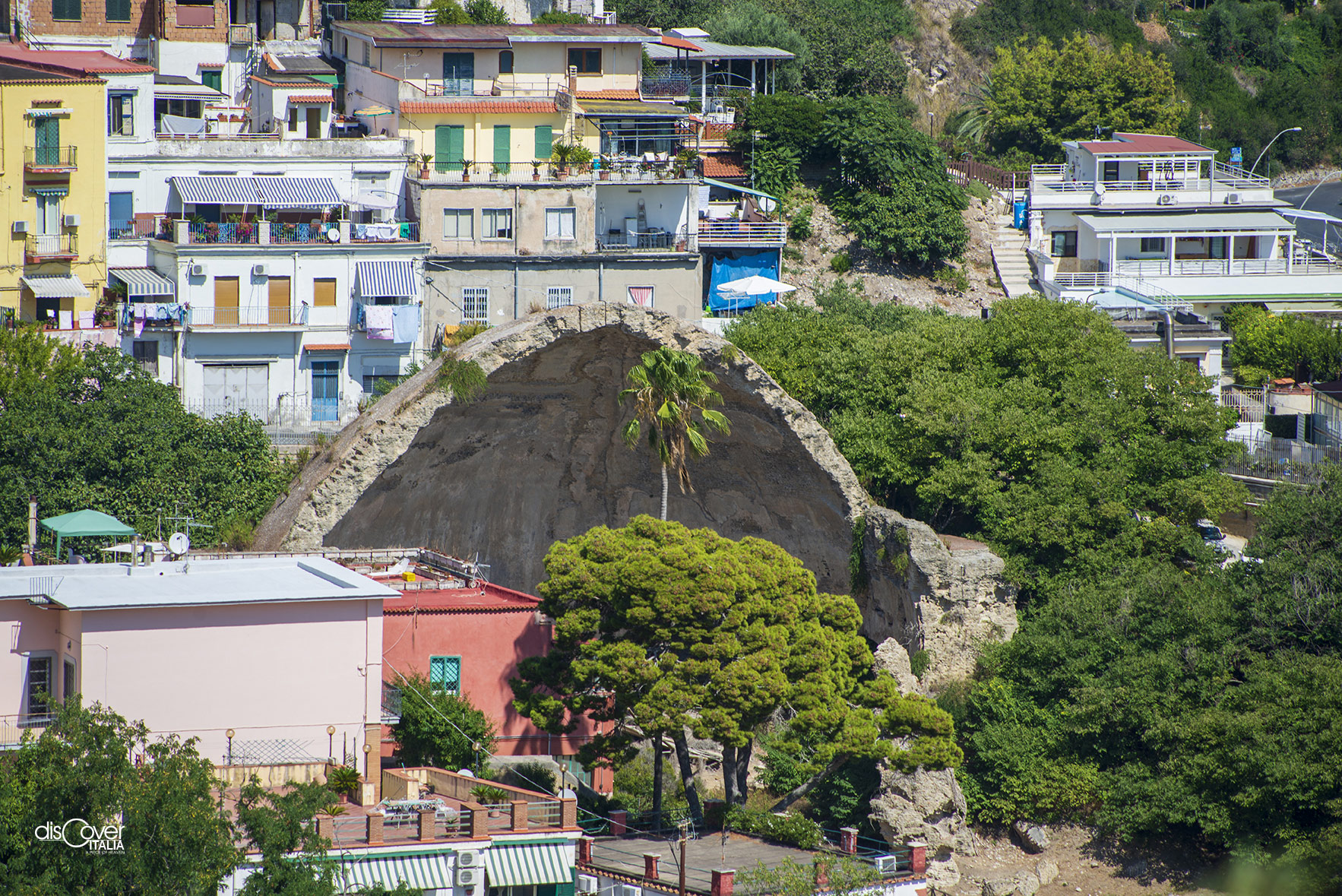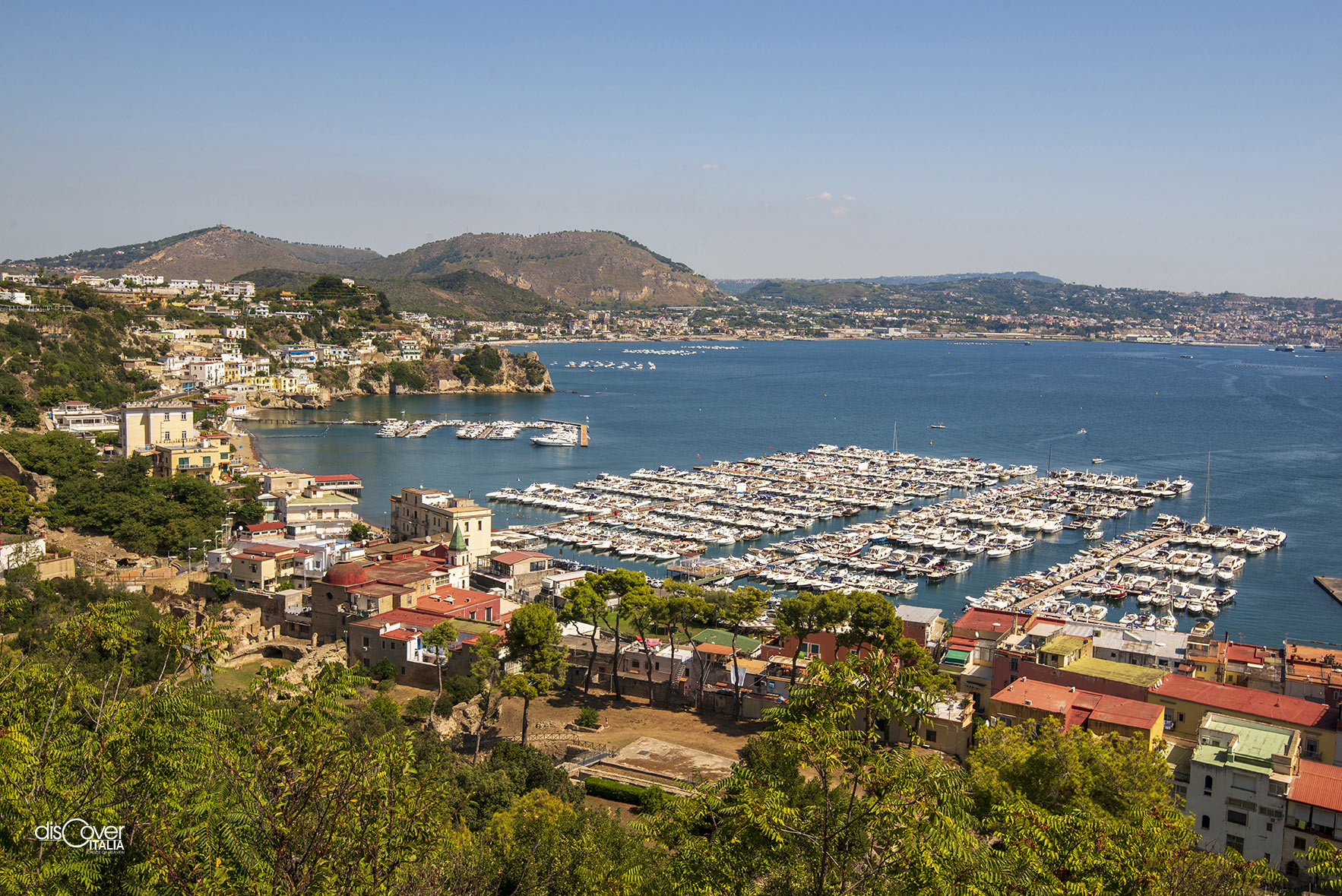«No other place shines more than the pleasant Bay"
Orazio
The name of the bay is linked to the legendary trip of Ulysses who buried there his friend Bajos. It was the landing place of Cumae and especially the most exalted phlegraean location, praised and frequented for its environmental delights and for its thermal springs. A holiday resort frequented by rich patricians and intellectuals. Not surprisingly the great Horace wrote: «Nulhes in orbe sinus Bais praelucel amoenis» (“There is no place in the world more beautiful than the delightful Baia”). As is is known, due to bradyseism, a considerable part of the ancient city has been immersed in the sea. Along the way to Baia, the Monte Nuovo is outlined: a small volcanic hill of 140 meters high which owes its reputation to the fact that is was formed in few hours during the eruption on the 29th-30th of September 1538, which buried the thermal village of Tripergole and caused the depopulation of Pozzuoli: it is the youngest mount of Europe. On its slopes, an interesting Natural Oasis has been inaugurated in 1996 with the purpose of protecting the geological, botanical and zoological resources of the Phlegraean Fields. Then you can admire the Lake Lucrino: there, the Romans dug the first tuff caves in order to use the therapeutic properties of the volcanic fumaroles and they built sumptuous villas and, of course, several thermal baths on very hot thermal springs (the water flows at a temperature oscillating between 58 and 74 degrees) which are nowadays still used as modern establishments. Moving close to Baia, we pass through Punta dell’Epitaffio: the view is very special and it covers an amazing archeological site which is the Underwater Archeological Park which you can visit on board of typical glass-bottomed boats, from which you can admire the remains of the most important thermal place of the Empire, the «Pusilla Roma» ( how Baiae used to be called).
A holiday resort frequented by rich patricians and intellectuals. Not surprisingly the great Horace wrote: «Nulhes in orbe sinus Bais praelucel amoenis» (“There is no place in the world more beautiful than the delightful Baia”). As is is known, due to bradyseism, a considerable part of the ancient city has been immersed in the sea. Along the way to Baia, the Monte Nuovo is outlined: a small volcanic hill of 140 meters high which owes its reputation to the fact that is was formed in few hours during the eruption on the 29th-30th of September 1538, which buried the thermal village of Tripergole and caused the depopulation of Pozzuoli: it is the youngest mount of Europe. On its slopes, an interesting Natural Oasis has been inaugurated in 1996 with the purpose of protecting the geological, botanical and zoological resources of the Phlegraean Fields. Then you can admire the Lake Lucrino: there, the Romans dug the first tuff caves in order to use the therapeutic properties of the volcanic fumaroles and they built sumptuous villas and, of course, several thermal baths on very hot thermal springs (the water flows at a temperature oscillating between 58 and 74 degrees) which are nowadays still used as modern establishments. Moving close to Baia, we pass through Punta dell’Epitaffio: the view is very special and it covers an amazing archeological site which is the Underwater Archeological Park which you can visit on board of typical glass-bottomed boats, from which you can admire the remains of the most important thermal place of the Empire, the «Pusilla Roma» ( how Baiae used to be called). In fact, the complex of the 1st- 4th century A.D has yet to be identified in its functions for the particular types of distribution of the spaces. But the thermal destination of some rooms is evident: they are very elaborated technically, like the dome of the Temple of Mercury. Then, the Villa of the Ambulatio, the so-called complex of Sosandra (Aphrodite Sosandra was the “men’s protector”), the Temples of Diana and Venus.
In fact, the complex of the 1st- 4th century A.D has yet to be identified in its functions for the particular types of distribution of the spaces. But the thermal destination of some rooms is evident: they are very elaborated technically, like the dome of the Temple of Mercury. Then, the Villa of the Ambulatio, the so-called complex of Sosandra (Aphrodite Sosandra was the “men’s protector”), the Temples of Diana and Venus.
The finds of statues, mosaics and decorations are kept in the Aragonese Castle of Baiae, where the Archaeological Museum of the Phlegraean Fields is locate, emblem of this Land of Myth. The castle was built in a strategic position on a tuff promontory, in order to dominate the whole gulf of Pozzuoli and the arm of the sea which includes the three parthenopean islands. It has been erected on the ruins of a roman villa (you can see the remains from the sea) and it was an example of fortification for the era, with walls, ditched and drawbridges, impregnable in fact. Its construction started with other works of the defensive system arranged by king Alfonso of Aragon in 1495, in anticipation of the invasion of Charles VIII. The viceroy Pedro de Toledo requested to carry out expansion works between 1538 and 1550. Two big rooms of the museum are housing the reconstruction of the famous Shrine of the Augustals and a series of plaster casts found in the thermal baths of Sosandra (some dozens of fragments attributable to well-known original Greek bronze pieces) and a wonderful copy of Aphrodite found in Miseno in 1980., The equestrian statues of Minerva, Titus and Vespasian, plates and engravings stand out between the other statues. Inside, the splendid and famous Triclinium-Ninfeo of Punta Epitaffo, the sumptuous imperial dining room has been rebuilt, surrounded by sculptural busts, spectacular recreations of areas and a rich decoration of sculptures such as Ulysses with his companions Cyclopes Polyphemus.
Other important and imposing testimonies of the ancient Baia only visible between the hill and the sea: remains of luxurious private villas, pools and thermal baths, the so-called temples of Diana and Venus and the Thermal Baths of Mercury. The archaeological park extends over an area of 14 he hectares divided into three sections. Southward, there is the Venus Temple’s equipment which extended to the goddess of beauty’s temple. In the centre, there is the Thermal Baths of the Aphrodite Sosandra, with residences and gardens porticos which were once adorned with mosaics, statues and polychrome paintings. Eastwards there is the Thermal Baths of Mercury with the remaining of a frigidarium.



Comments powered by CComment